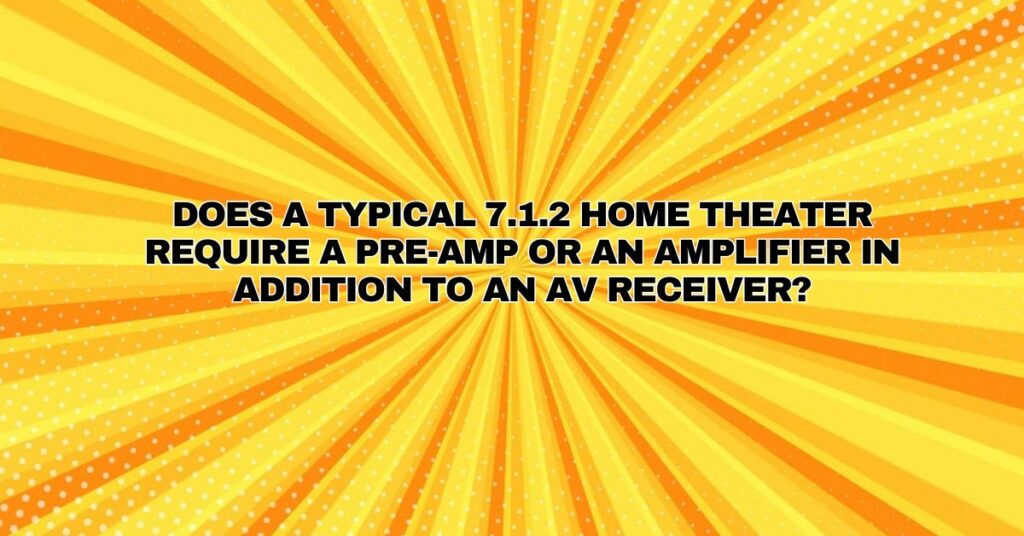Building a home theater system is a thrilling endeavor for audio and movie enthusiasts. The advent of immersive audio formats like Dolby Atmos has pushed the boundaries of home theater, offering a cinematic experience in the comfort of your living room. However, configuring a 7.1.2 home theater setup can be complex, leading to questions about the necessity of a preamp or amplifier in addition to an AV receiver. In this comprehensive article, we will explore the components, their roles, and when and why you might need to incorporate additional equipment to create the ultimate home theater experience.
The Anatomy of a 7.1.2 Home Theater
Before diving into the necessity of a preamp or amplifier, let’s break down the components of a 7.1.2 home theater system:
- AV Receiver: The heart of your home theater, the Audio-Visual (AV) receiver serves as the central hub. It processes audio and video signals, decodes various audio formats, and powers the speakers.
- Speakers: In a 7.1.2 setup, you have a total of 7 main speakers, 1 subwoofer, and 2 overhead or height speakers.
- Subwoofer: The subwoofer handles low-frequency sound (bass) and adds depth and impact to your audio.
- Preamp (Preamplifier): The preamp, in some cases, may be built into the AV receiver and is responsible for managing the source selection, volume control, and often, processing tasks.
- Amplifier: Amplifiers provide power to the speakers, driving them to produce sound.
AV Receiver Capabilities
Modern AV receivers are highly versatile and come equipped with numerous features. Here are some of their primary functions:
- Audio Processing: AV receivers decode audio signals in various formats (e.g., Dolby Atmos, DTS:X) and distribute them to the appropriate speakers.
- Video Processing: They switch and distribute video signals from different sources to your display.
- Preamp Functions: Many AV receivers include preamp functions for source selection, volume control, and basic tone adjustments.
- Amplification: Most AV receivers have built-in amplifiers, which can power a 7.1.2 speaker configuration.
When Do You Need a Separate Preamp?
Whether you need a separate preamp in a 7.1.2 home theater setup largely depends on the complexity of your audio system and your specific requirements. Here are some scenarios when a separate preamp might be beneficial:
- Advanced Processing: If you have a high-end audio system with advanced processing needs or if you are combining multiple audio sources and wish to have fine control over them, a dedicated preamp with sophisticated features may be preferable.
- Enhanced Audio Control: Some audiophiles prefer the more detailed control options that dedicated preamps provide, such as precise equalization settings, balanced XLR connections, and more extensive tone-shaping capabilities.
- Source Switching: In setups with numerous audio sources, a separate preamp can streamline the process of source selection and volume control. This is particularly useful for complex audio and video setups.
- Customization: If you want a highly customized and tailored audio experience, a separate preamp can offer a more flexible platform for achieving your audio goals.
When Do You Need a Separate Amplifier?
Separate amplifiers can also be integrated into a 7.1.2 home theater setup for specific reasons. Here are some scenarios when an external amplifier becomes essential:
- Enhanced Power: Large, high-quality speakers or systems with high power demands may require external amplification to deliver optimal performance.
- Sound Quality: Audiophiles seeking the utmost sound quality may opt for high-end, dedicated amplifiers that can produce cleaner, more powerful sound.
- Bi-Amping or Tri-Amping: In situations where you want to separately power the drivers (e.g., tweeters and woofers) within each speaker, external amplification is necessary.
- Scalability: If your audio system is designed for expansion, external amplifiers can offer the flexibility to add more channels for additional speakers.
Conclusion
In most 7.1.2 home theater setups, a high-quality AV receiver with built-in preamp and amplification capabilities is sufficient to deliver immersive audio and video experiences. However, there are scenarios where audiophiles and home theater enthusiasts may desire additional control, power, or customization, which can be achieved through the use of separate preamps and amplifiers.
Ultimately, the decision to include separate preamp or amplifier components hinges on your specific goals, your equipment, and your budget. It’s essential to carefully assess your needs, whether you prioritize simplicity or want to craft a high-end, personalized audio experience. By making informed choices, you can ensure that your 7.1.2 home theater setup meets your audio and visual expectations and delivers the cinematic thrills you desire.


